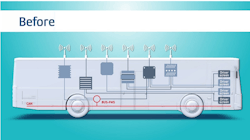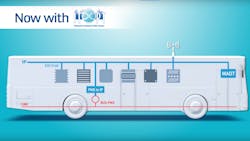Meeting the next big challenge for public transportation in 2023
The North American public transit industry hit a highpoint in 2016 with the "Mobility on Demand Sandbox Program” funded by the US Department of Transportation. This initiative resulted in 11 cities receiving nearly $8 million in funding to experiment with ways to improve the efficiency, effectiveness and customer experience of transportation services. What was born from that project was a public and private transportation partnership called Mobility as a Service (MaaS).
Today, nearly every major city has integrated ridesharing, scooters, bikes and carsharing with public transit services for a seamless rider experience. This was a huge step forward in the interoperability of transportation services.
However, there is more to be accomplished. The next big hurdle is to achieve better integration of communication protocols on public transit vehicles. Currently, buses are packed with mixed-vendor, proprietary equipment and interfaces which cannot speak to each other or share standard data. Standardization of on-board systems will allow transit agencies to simplify routines for maintenance, update or upgrade systems and devices quickly and offer greater flexibility. By simply providing a multipoint IP-based communication in the vehicle via a single antenna, all systems can exchange information using one communication gateway.
Who is leading the charge?
The ITxPT architecture is built on norms and recommended best practices from active implementations and initiatives like EBSF 2. The ITxPT requirements offer a structure for designing hardware and software to combine modules into a unified architecture. All on-board systems are connected to the host network by a single antenna under the control of a single communication gateway.
The IT design is not constrained by the ITxPT requirements. Even if they are made by different manufacturers, on-board modules and systems branded with the ITxPT standard can be used together. This makes it easier for IT suppliers to reach the market and allows transit agencies the freedom to choose services and parts from a variety of sources. They can be updated to include new features like Wi-Fi connectivity, power outlets, cutting-edge ticketing systems, mobile applications and so on. Furthermore, from a back-office level, installation and system expansions are easily enabled.
Why does it matter?
The ITxPT communication standard will facilitate the reduction of excessive reliance on proprietary system providers and remove the need for long-term maintenance of customized interfaces.
In North America, some transit agencies are already using ITxPT as a purchasing requirement to ensure that vehicles and IT systems are compatible with each other. As a strategic partner, INIT has worked to ensure more than a half dozen of its hardware and software solutions are certified with the ITxPT label.
Understanding ITxPT allows agencies to benefit from the full plug-and-play compatibility of vehicle systems and the extensive best practice experiences of other public transit providers who are using the same technology.
---------
Ann Derby is director of marketing and events at INIT.
How to get involved
The ITxPT specifications are publicly available from the ITxPT Documentation Centre and can be freely used by anyone. They provide public transport authorities and operators with recommendations and requirements to support the purchase and integration of interoperable IT architecture. Furthermore, industry suppliers use the specifications to design ITxPT-compliant equipment and services.

